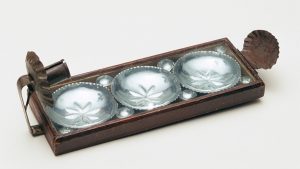Let There Be Light: Examining A 19th Century Sconce
As graduation quickly approaches, I have been reflecting on my two years here at Winterthur. One of my earliest projects for our Metals Connoisseurship block examines a tin sconce dating from the first half of the nineteenth-century, which I wanted to share here.
Fashioned of reflective tinned sheet iron to enhance the illumination of a candle, the production of this sconce speaks to a matter that vexed colonial and early America: a lack of quality light. Domestic lighting produced during the eighteenth and early nineteenth centuries for middling households was largely characterized by its ability to be moved in order to facilitate work. This sconce, designed to be hung on a wall, was likely used in a semi-public space—perhaps a tavern, theatre, or meeting house—which required diffuse, rather than direct, light. It is imitative of costlier sconces constructed with mirrored glass, or occasionally mother of pearl, arranged in radial patterns behind the candle.

Figure 1: Sconce, United States (New England or Mid-Atlantic), Tinned Sheet Iron, Glass, Pine, Iron Wire, 1800-1840. Courtesy, Winterthur Museum, Garden and Library.
Long, slender rectangular sconces crafted entirely from tinned sheet iron were popularized in the eighteenth century and were produced well into the nineteenth century. The term “sconce” is mentioned frequently in period newspapers and diary entries, though some accounts alternatively use the phrase, “flat backed candlestick.” There was no linguistic distinction made between sconces crafted entirely out of tinned sheet iron and those encased in wood frames. Derived from the Latin word, “absconsus,” meaning “hidden or concealed,” sconces in the medieval period were often covered, much like lanterns, to shelter the candle flame from drafts.
The construction of this sconce demonstrates the ways in which tinsmithing changed in the early nineteenth century as the craft increasingly relied on specialized tools and machines. A vertical rectangular pine frame, faced with glass, encloses three circular dished reflectors that span the length of the sconce’s case. The frame, held together by wrought nails and animal hide glue, suggests that this sconce was produced by a tinsmith, rather than a cabinetmaker, who would have used dovetails, not nails, to join the frame. Traces of red paint remain on the frame, though it is unclear whether this paint was original to the sconce’s production. The reflectors, each artfully die-stamped with an eight-petaled flower, are held in place with wrought finishing nails. Crimped at the edges, the reflectors mimic the crimping found around the drip pan and the shell-like tinned sheet iron hood atop the frame. The hood, now oxidized to dark gray, serves a dual purpose: to reflect light from the candle downward and to protect the ceiling from the candle’s smoke. The regularity of the crimping on the reflectors suggests it was likely produced by machine, whereas crimping was previously done by hammering the tin into a ‘v’ shape on a swage. An increasing number of specialized tools and machines were produced for the tinsmithing trade throughout the nineteenth-century.
Soldered to the three central reflectors and positioned at the frame’s edge are eight smaller circular cups. The irregularity of these pieces—they vary greatly in size and slightly in execution of design—suggests that they were produced by hand and hammer. The trade of tinsmithing is dependent on a thorough understanding of geometry and a practice of precision. The irregularity of these small circular cups suggests that the craftsman who produced this sconce was not working from a pattern, like one might expect had sconces of this style been a staple of his workshop. Records from tinsmiths confirm that sconces were not widely manufactured during this period, though they were listed in an index of wholesale prices of tinware at a cost of two dollars per dozen.
Nailed to the bottom of the frame is a support for the candlestick made of a heavier piece of tinned sheet iron—in 1817 there were approximately fifteen weights of tinned sheet iron—that has been folded inward by machine on both sides. It is soldered to the drip pan, upon which sits a rounded piece of tinned sheet iron that holds the candle. This piece was likely produced by hammering the sheet iron around a candle mold stake to ensure proper fit of the candle. The edge is rolled, and there is a slit on the side that facilitates the removal of the remnants of a melted candle.

Figure 2: The back of the sconce has faint writing in chalk that likely says “rear jam,” which was probably added in the twentieth-century by workers installing the fixture at Winterthur.
Tinned sheet iron was primarily imported from Germany and Wales in the first half of the nineteenth-century; it arrived by ship to the ports of Philadelphia, Boston, New York City, and occasionally New Orleans, and was subsequently transported to various locales. Boxes of tinned sheet iron, each weighing 112 pounds, were retailed by middlemen to tinsmiths. At times there were shortages of tin in rural areas and during periods of war, which prompted tinsmiths to buy and sell to one another or to travel to acquire the material. Tinsmiths produced a variety of wares, most commonly coffee pots, kettles, cans, buckets, and later, stove pipes. Sconces would have represented a small fraction of the tinsmith’s production. These wares were sometimes sold directly to consumers, though a network of peddlers and general stores emerged in the late eighteenth-century to help distribute tinware. Tinsmithing, a lucrative profession in the early nineteenth-century, developed vast trade networks in the New England and Mid-Atlantic markets, Canada, and the American South. The production of this sconce illustrates not only the desire for diffuse lighting for public spaces, but also the specialization of trades and the complexity of business operations that were beginning to develop in the United States following the American Revolution.
By Trent Rhodes, WPAMC Class of 2018

Leave a Reply